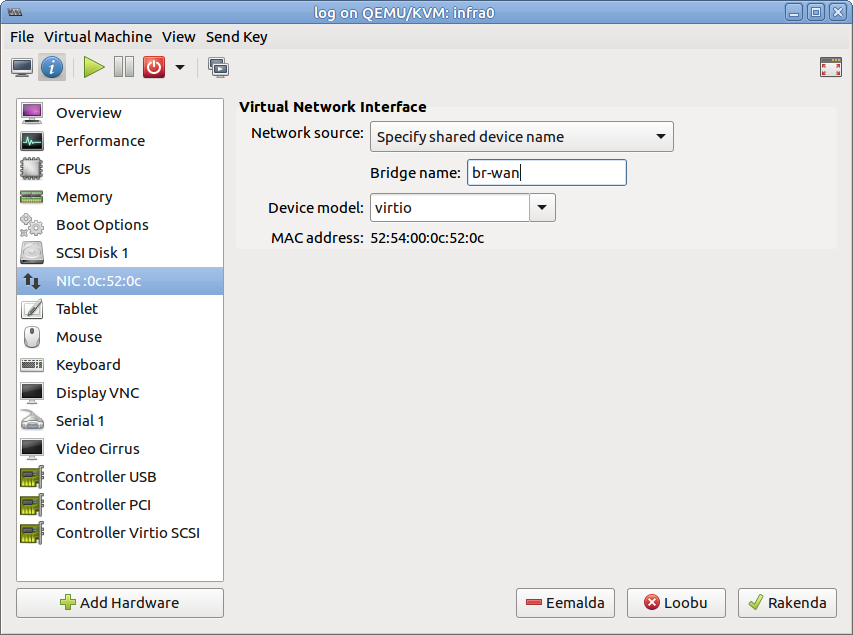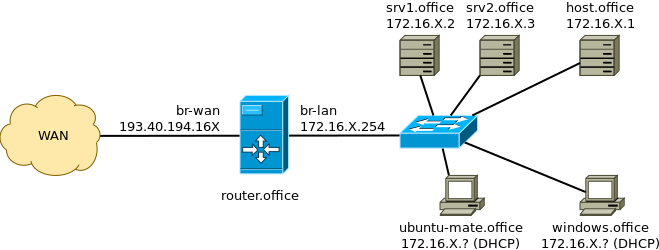Category:I802 Firewalls and VPN IPSec: Difference between revisions
No edit summary |
|||
| Line 208: | Line 208: | ||
Internal IP address of the physical server (port no 2 = enp0s9): 172.16.3.1/24 | Internal IP address of the physical server (port no 2 = enp0s9): 172.16.3.1/24 | ||
Services: | Services: | ||
* IRC, for chatting | * IRC, for chatting (Meelis Hass) | ||
* [https://github.com/ether/etherpad-lite Etherpad] for collaborating | * [https://github.com/ether/etherpad-lite Etherpad] for collaborating (Sheela) | ||
* [https://github.com/laurivosandi/certidude#usecases Certificate management] for roadwarriors, usecase number #1 | * [https://github.com/laurivosandi/certidude#usecases Certificate management] for roadwarriors, usecase number #1 (Artur O) | ||
* Monitoring software of your choice to make sure that services are up and running, possibly use LDAP for authentication | * Monitoring software of your choice to make sure that services are up and running, possibly use LDAP for authentication | ||
* E-mail for sending notifications from monitoring software at first | * E-mail for sending notifications from monitoring software at first (Ilja), this needs MX records in DNS | ||
* Later, in the beginning just monitor public services: OpenVPN connection to headquarters | * Later, in the beginning just monitor public services: OpenVPN connection to headquarters | ||
Revision as of 11:42, 3 October 2016
Firewalls and VPN/IPSec
General information
ECTS: 4
Lecturer: Lauri Võsandi
Scenario
In this course we will attempt to set up a network similar to a corporate network with multiple offices, eg http://docplayer.it/docs-images/20/596222/images/25-0.png
We will use VPN software to connect subnets to each other and we will use VPN software to connect our personal computers to the intranet.
Setting up virtual machine hosts
For this course we have 3 Sun servers, each with 16GB of RAM. In each server we should be able to create 3 or more virtual machines. As host operating system we will install Ubuntu 16.04 server. On disks set up ext4 on mdraid set up in RAID1 configuration.
For virtualization let's use libvirt and virt-manager on your Ubuntu laptops, for Windows and Mac unfortunately there is no decent UI available instead installing web interface such as Kimchi is recommended.
To install libvirt on the server:
apt install libvirt-bin qemu-kvm
Also add the primary user to the libvirt group:
sudo gpasswd -a $USER libvirt
On your laptop first set up SSH keys between the laptop and server with ssh-keygen and ssh-copy-id. And then you can install virt-manager with:
sudo apt install virt-manager
Copy CD ISO files into /var/lib/libvirt/images using scp or FileZilla.
Continue with creating a virtual machine for each service. For Windows 2012 server virtual machines use 2G of RAM and 50G of storage. For Ubuntu 16.04 server installations use 1G of memory and 50G storage. For Ubuntu 16.04 MATE desktop installations use 2G of RAM.
In order to set up virtual switch inside the server use Linux's built-in bridges, start with installing bridge-utils:
apt install bridge-utils
Reconfigure your server's /etc/network/interfaces, replace X with number relevant to your server. Also replace eth0, eth1 and eth2 with the network interfaces available in your machine:
# The loopback network interface auto lo iface lo inet loopback # Wide area network interface auto br-wan iface br-wan inet dhcp # Until we set up router in a VM we will use DHCP so we can have internet access in 417 bridge_ports eth0 # Local area network interface auto br-lan iface br-lan inet static address 172.16.X.1 netmask 255.255.255.0 bridge_ports eth1 # Management interface auto eth2 iface eth2 inet static address 192.168.12.1X netmask 255.255.255.0
When creating virtual machines, configure network as shown in the screenshot below:
This way your VM-s should be able to access the Internet as the physical machine can
Setting up router
On Wednesday 14. September we will configure OpenWrt as a router in a virtual machine. Download the OpenWrt image and uncompress it:
cd /var/lib/libvirt/images/ wget http://185.94.112.87/openwrt.org/chaos_calmer/15.05.1/x86/kvm_guest/openwrt-15.05.1-x86-kvm_guest-combined-ext4.img.gz gunzip openwrt-15.05.1-x86-kvm_guest-combined-ext4.img.gz
Add second network interface to your router's VM. Configure first NIC as connected to br-wan and second one connected to br-lan.
After that you should end up with topology similar to this:
To clarify: 'srv1.office' and 'srv2.office' are the Ubuntu 16.04 servers, you should have configured static IP addresses or set a static lease from the router. The 'router.office' refers to the OpenWrt router you just set up. The router serves IP addresses using DHCP to 'ubuntu-mate.office' Ubuntu MATE 16.04 workstation and 'windows.office' refers to Windows workstation. Your physical server 'host.office' can be accessed as well. The 'office' throughout the diagram refers to your domain name, use abbrevations such as hq, rnd, devops for that.
Offices
Headquarters
Gateway: 193.40.194.220
DNS: 193.40.0.12, 193.40.56.245
Public IP address (port no 0 = enp6s4f0): 193.40.194.160/24
Management network IP address (port no 1 = enp6s4f1), accessible from robotics club: 192.168.12.10
Internal IP address of the physical server (port no 2 = enp0s9): 172.16.1.1/24
Team members: Keijo, Anton, Mohanad, Etienne
Services:
- BIND9 as public DNS server, also figure out what domain name we should/can use
- domain controller, at this point primarily for user accounts (Keijo)
- nginx web server, for company's homepage (Anton)
- SMB/CIFS fileserver, join to domain (Etienne)
- VPN server for other subnets, presumably OpenVPN (Mohanad Aly)
Research & development
Gateway: 193.40.194.220
DNS: 193.40.0.12, 193.40.56.245
Public IP address (port no 0 = enp6s4f0): 193.40.194.161/24
Management network IP address (port no 1 = enp6s4f1), accessible from robotics club: 192.168.12.11
Internal IP address of the physical server (port no 2 = enp0s9): 172.16.2.1/24
Team members: Marvin, Madis, Taavi, Berit, Joosep
Services:
- Git hosting, for sharing scripts, set up LDAP to authenticate with domain controller
- Wiki, for exchanging information, set up LDAP to authenticate with domain controller and later possibly configure web server to authenticate with Kerberos
- Windows XP workstation, join to domain
- Ubuntu 16.04 MATE workstation, join to domain.
- LTSP server
- OpenVPN connection to headquarters, use shared secret at first, later X509 certificates
- Pastebin, possibly later implement Kerberos support (Berit)
Examples
Port forwarding example, we have 2 linux virtual machines, one forwarding to host local ip.

Network interface example file:
auto lo iface lo inet loopback # Wide area network interface (port 0) auto br-wan iface br-wan inet manual bridge_ports enp6s4f0 # Local area network interface (port 3) auto br-lan iface br-lan inet static address 172.16.2.1 gateway 172.16.2.254 dns-nameserver 172.16.2.254 netmask 255.255.255.0 bridge_ports enp0s8 # Management interface (port 1) auto enp6s4f1 iface enp6s4f1 inet static address 192.168.12.11 netmask 255.255.255.0
Openwrt interface file working example /etc/config/network:
config interface 'lan'
option ifname 'eth0'
option type 'bridge'
option proto 'static'
option netmask '255.255.255.0'
option ip6assign '60'
option ipaddr '172.16.2.254'
config interface 'wan'
option ifname 'eth1'
option proto 'static'
option ipaddr '193.40.194.161'
option gateway '193.40.194.220'
option netmask '255.255.255.0'
option dns '192.40.0.12 193.40.56.245'
To create poor man's vpn. Install on your computer
apt install sshuttle
and connection.
sshuttle --dns -HNvr username@server:port
no you should be able to connect local network computers and services. NB! ping is not working with sshuttle you can read more here http://teohm.com/blog/using-sshuttle-in-daily-work/
TODO
Devops
Gateway: 193.40.194.220
DNS: 193.40.0.12, 193.40.56.245
Public IP address (port no 0 = enp6s4f0): 193.40.194.162/24
Management network IP address (port no 1 = enp6s4f1), accessible from robotics club: 192.168.12.12
Internal IP address of the physical server (port no 2 = enp0s9): 172.16.3.1/24
Services:
- IRC, for chatting (Meelis Hass)
- Etherpad for collaborating (Sheela)
- Certificate management for roadwarriors, usecase number #1 (Artur O)
- Monitoring software of your choice to make sure that services are up and running, possibly use LDAP for authentication
- E-mail for sending notifications from monitoring software at first (Ilja), this needs MX records in DNS
- Later, in the beginning just monitor public services: OpenVPN connection to headquarters
Pentest
Find security issues in the deployed services.
Team members: Kustas, Ender, Indrek (?)
Report template
Send report as a plaintext e-mail to Lauri, in the title include: Report #number - your name - your team
In the content make sure you specify the timespan you're talking about (September of 2016, first half of October 2016 etc)
The content, no need for formal speech:
- What have been done so far by the team (eg. server hardware setup, virtual machine setup, service setup)
- What was your role for this timespan, note that we will shuffle the teams now and then
- What was your contribution, or in other words what did you do during this timespan
- What (security) incidents happened - red team found messing around with the servers, passwords changed, backdoor found etc.
This category currently contains no pages or media.

